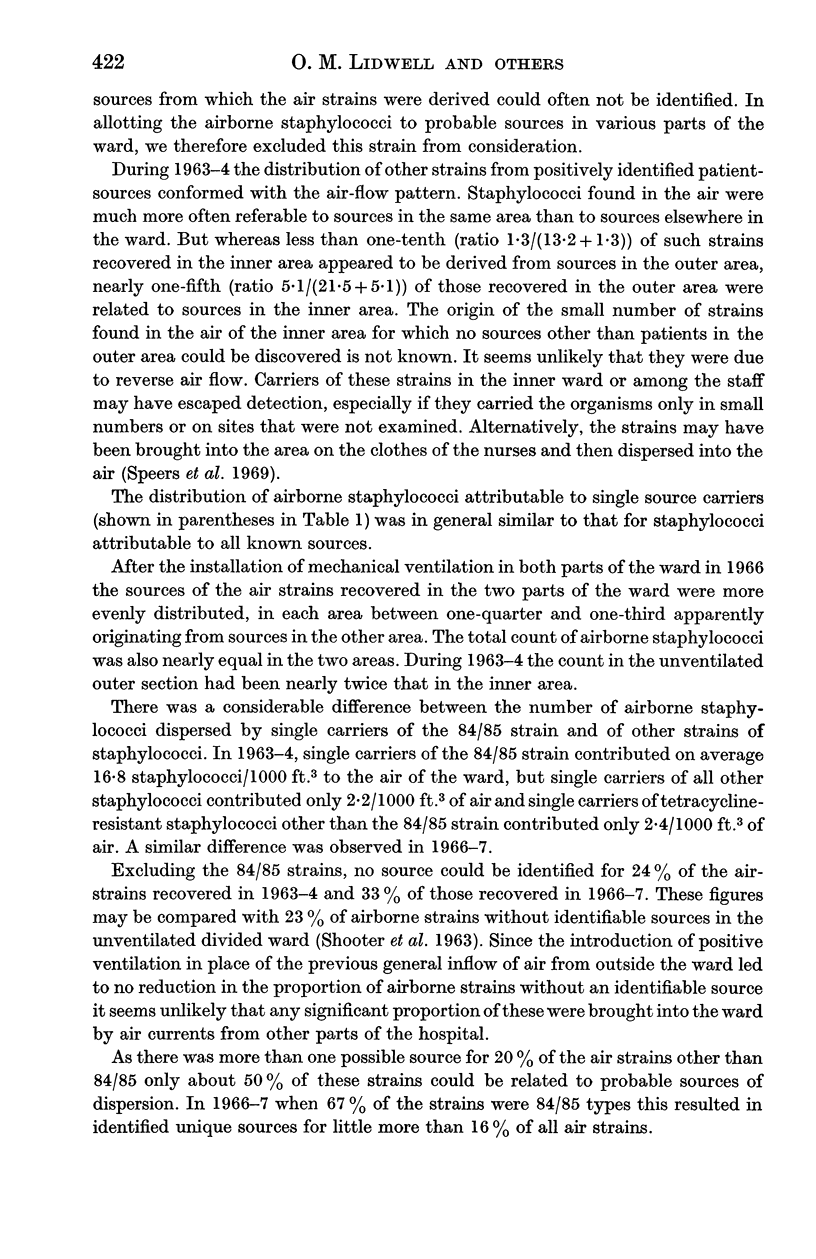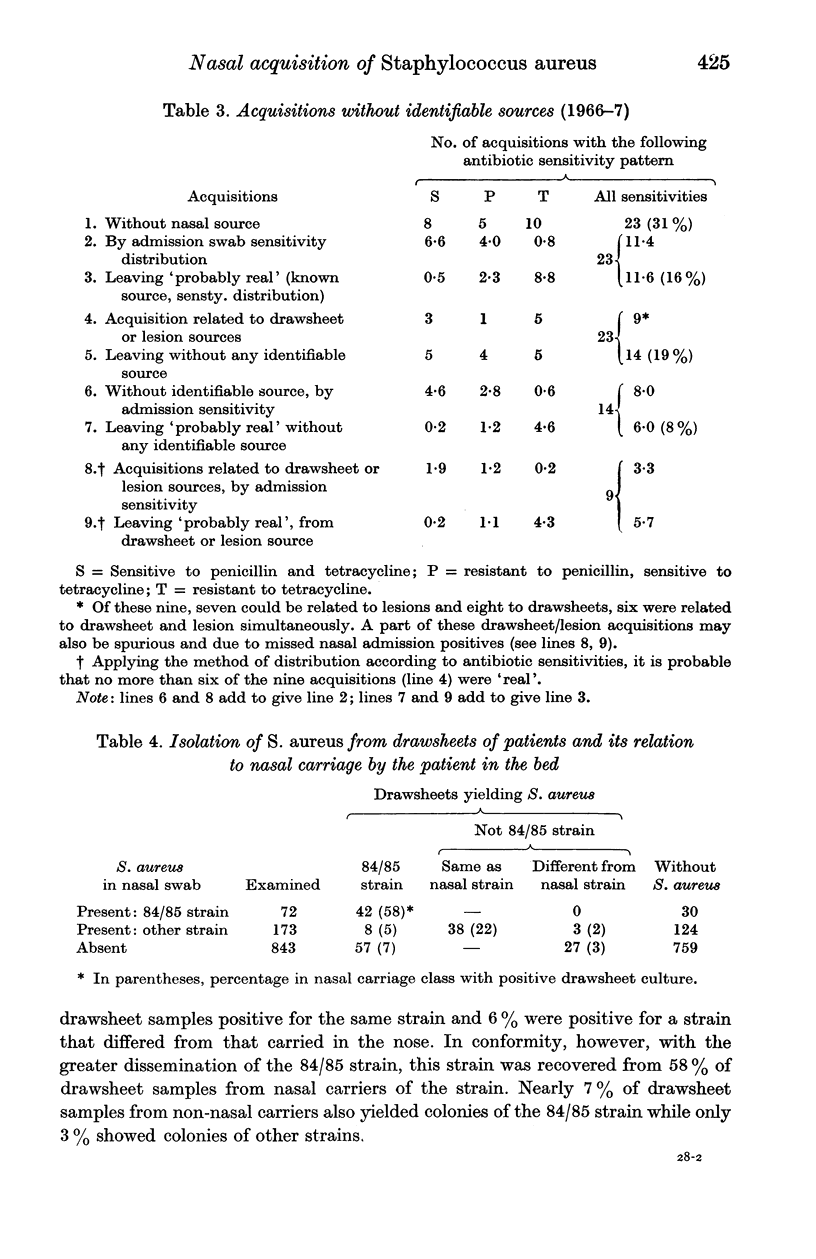Abstract
An investigation was made of nasal acquisition of Staphylococcus aureus and of staphylococcal wound sepsis in a hospital ward divided into two sections and provided with mechanical ventilation, so that there was no transfer of air from one of the sections to the other. Although the strains of S. aureus found in the air, and those colonizing the noses of patients, in the protected section could seldom be related to patients nursed elsewhere in the ward, the mechanical ventilation did not lead to any significant reduction in the degree of contamination of the air or in the rate of nasal acquisition of S. aureus.
Even in the protected section, nearly 20% of the strains of S. aureus recovered from the air could not be related to known nasal carriers. Since this proportion was nearly as great as that found in the absence of directed air-flow, it seems probable that these strains were derived either from undetected sources within the section or were dispersed from the clothes of persons who entered it.
Nearly one-third of the nasal acquisitions in the ward could not be related to known nasal carriers, but about one-half of these (16%) were probably `spurious' and half of the remainder (8%) could be related to strains recovered from patients' lesions or drawsheets, leaving no more than 8% unaccounted for. A short investigation in which both drawsheet and perineal samples were examined showed that drawsheet samples did not give a reliable indication of perineal carriage unassociated with nasal carriage.
During the period of the investigation, a single strain of S. aureus that was resistant to a wide range of antibiotics established itself in the ward. The most notable character of this strain was the profuse dispersion of it by carriers. As a consequence, staphylococcal wound sepsis increased, with nearly three-quarters of the infections attributable to this strain, and nasal carrier rates increased with length of stay in the ward, over 20% of patients who stayed 5-6 weeks acquiring the strain.
Full text
PDF
















Selected References
These references are in PubMed. This may not be the complete list of references from this article.
- Lidwell O. M., Polakoff S., Jevons M. P., Parker M. T. Staphylococcal infection in thoracic surgery: experience in a subdivided ward. J Hyg (Lond) 1966 Sep;64(3):321–337. doi: 10.1017/s0022172400040602. [DOI] [PMC free article] [PubMed] [Google Scholar]
- Noble W. C. The dispersal of staphylococci in hospital wards. J Clin Pathol. 1962 Nov;15(6):552–558. doi: 10.1136/jcp.15.6.552. [DOI] [PMC free article] [PubMed] [Google Scholar]
- PARKER M. T., JOHN M., EMOND R. T., MACHACEK K. A. ACQUISITION OF STAPHYLOCOCCUS AUREUS BY PATIENTS IN CUBICLES. Br Med J. 1965 Apr 24;1(5442):1101–1105. doi: 10.1136/bmj.1.5442.1101. [DOI] [PMC free article] [PubMed] [Google Scholar]
- SHOOTER R. A., THOM B. T., DUNKERLEY D. R., TAYLOR G. W., PARKER M. T., JOHN M., RICHARDS I. D. PRE-OPRATIVE SEGREGATION OF PATIENTS IN A SURGICAL WARD. Br Med J. 1963 Dec 21;2(5372):1567–1569. doi: 10.1136/bmj.2.5372.1567. [DOI] [PMC free article] [PubMed] [Google Scholar]
- Speers R., Jr, Shooter R. A., Gaya H., Patel N. Contamination of nurses' uniforms with Staphylococcus aureus. Lancet. 1969 Aug 2;2(7614):233–235. doi: 10.1016/s0140-6736(69)90003-8. [DOI] [PubMed] [Google Scholar]
- WILLIAMS R. E., JEVONS M. P., SHOOTE R. A., THOM B. T., NOBLE W. C., LIDWELL O. M., WHITE R. C., TAYLOR G. W. Isolation for the control of staphylococcal infection in surgical wards. Br Med J. 1962 Aug 4;2(5300):275–282. doi: 10.1136/bmj.2.5300.275. [DOI] [PMC free article] [PubMed] [Google Scholar]
- Whyte W., Howie J. G., Eakin J. E. Bacteriological observations in a mechanically ventilated experimental ward and in two open-plan wards. J Med Microbiol. 1969 Aug;2(3):335–345. doi: 10.1099/00222615-2-3-335. [DOI] [PubMed] [Google Scholar]


